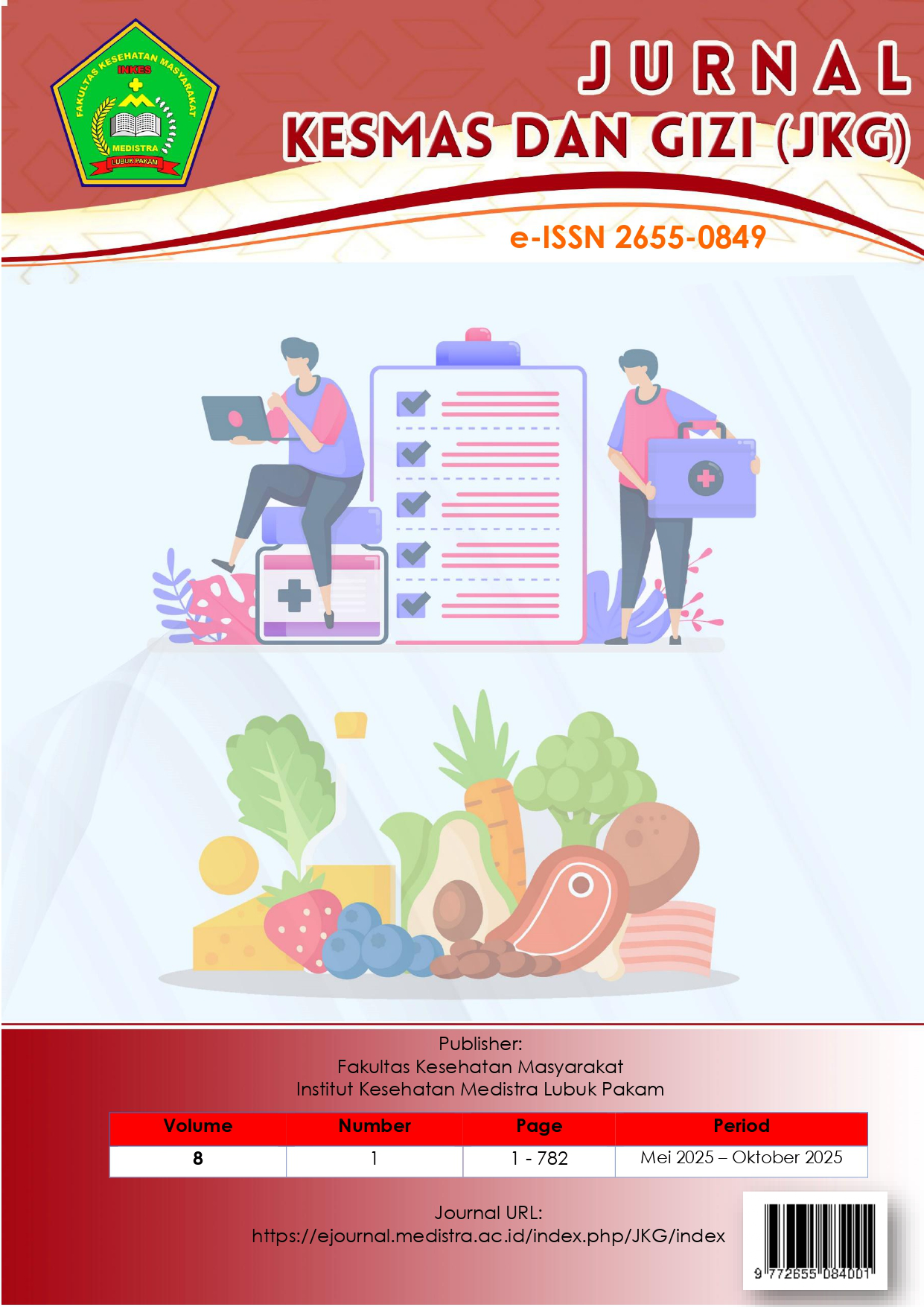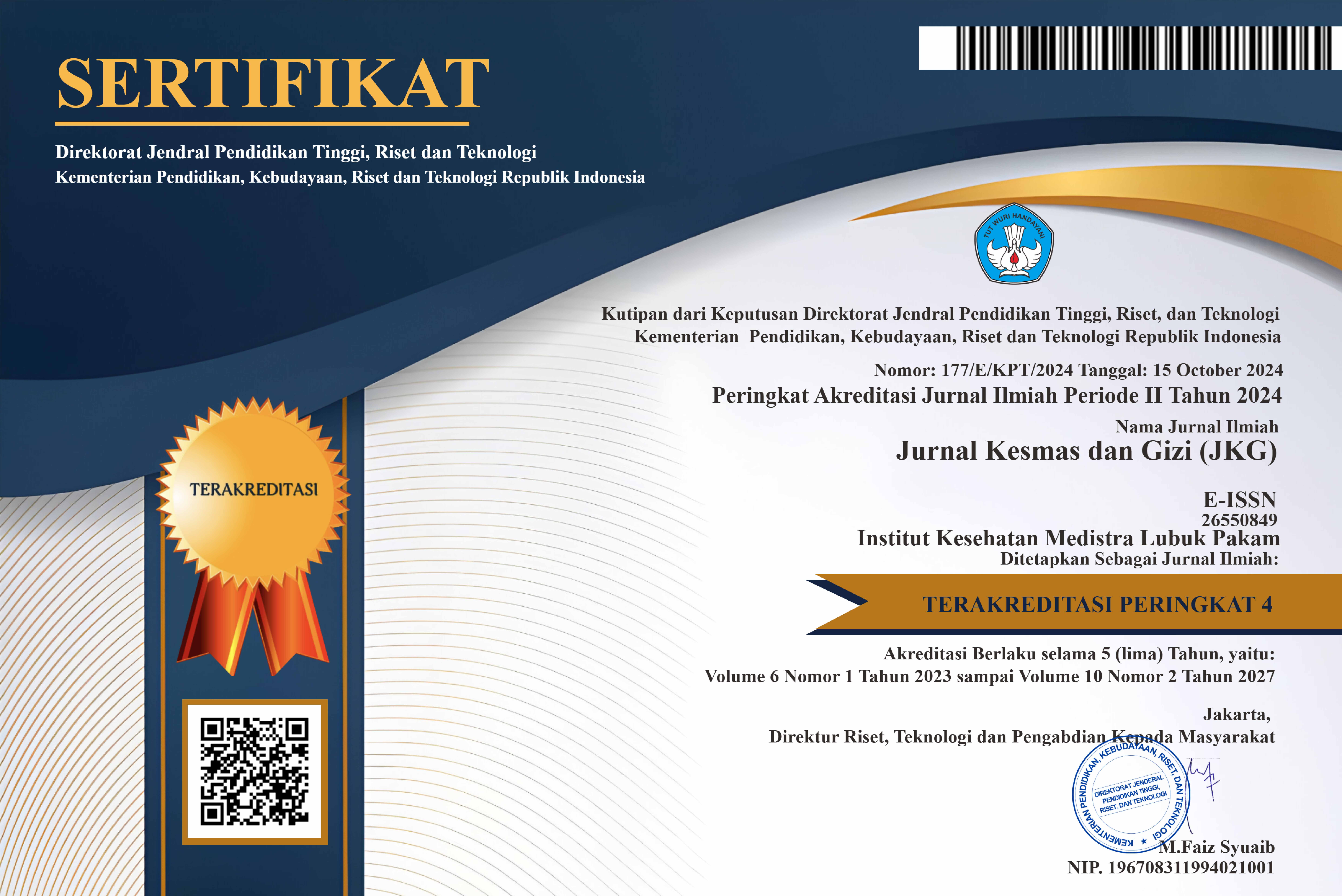Relationship Between the Mid-Upper Arm Circumference of Pregnant Women and the Birth Length of Newborn Babies.
DOI:
https://doi.org/10.35451/3pgjq989Keywords:
mid-upper arm circumference, birth length, pregnant women, chronic energy deficiency, GroboganAbstract
Birth length has been used as an indicator of infants' nutritional status, reflecting the results of linear fetal growth during pregnancy. Meanwhile, the nutritional status of pregnant women can be assessed using the mid-upper arm circumference (MUAC). In Indonesia, MUAC is primarily utilized to classify chronic energy deficiency (CED) and has not been explored as a predictor of infants' nutritional status based on birth length. This study aims to analyze the relationship between MUAC and birth length. A retrospective cohort study was conducted involving 55 pregnant women aged 20-35 years who attended prenatal check-ups and gave birth between January and December 2018. Data were collected from patient records at the Maternal and Child Health Unit of Pulokulon I Community Health Center in Grobogan Regency in July 2019. Pregnant women with incomplete data, those diagnosed with anemia, and babies born prematurely were excluded from the analysis. Data were analyzed using the Rank-Spearman correlation test with SPSS version 16. The analysis of maternal demographic characteristics revealed that only maternal age had a significant impact on the baby's birth length, with a Pearson correlation test showing p = 0.04. The average maternal mid-upper arm circumference was 26.01 ± 3.45 cm, while the average birth length was 48.76 ± 1.49 cm. The study concluded that there was no significant relationship between maternal mid-upper arm circumference and birth length (p-value = 0.931). Further research is needed across various community health centers, involving a larger sample size and additional maternal variables, to determine the effectiveness of mid-upper arm circumference as an indicator for predicting infants' nutritional status.
.
Downloads
References
[1] Kementerian Kesehatan RI. Profil Kesehatan Indonesia Tahun 2009. Jakarta: Kementerian Kesehatan Republik Indonesia; 2010.
[2] Kementerian Kesehatan RI. Buku Standard Antropometri Kementerian Kesehatan RI 2010. Jakarta: 2011.
[3] Kementerian Kesehatan RI. Situasi Balita Pendek (Stunting) di Indonesia. 2018.
[4] Dewey KG, Begum K. Why Stunting Matters. Washington, D.C.: 2010.
[5] Candra RS, Irene KM. Hubungan Asupan Gizi Dan Status Gizi Ibu Hamil Trimester II Dengan Berat Badan Lahir Rendah Bayi Di Wilayah Kerja Puskesmas Suruh Kabupaten Semarang. Journal of Nutrition College , Volume 3 , Nomor 1 , Tahun 2014 , Halaman 192-199. http://ejournal-s1.undi. Journal of Nutrition College 2014;3:192–9.
[6] Ariyani DE, Achadi EL, Irawati A. Validitas Lingkar Lengan Atas Mendeteksi Kekurangan Energi Kronis Pada Wanita. Jurnal Kesehatan Masyarakat 2014;7:83–90.
[7] Kusparlina EP. Hubungan Antara Umur Dan Status Gizi Ibu Berdasarkan Ukuran Lingkar Lengan Atas Dengan Jenis BBLR. Jurnal Penelitian Kesehatan Suara Forikes 2016;VII:21–6.
[8] Kementerian Kesehatan RI. Situasi Balita Pendek. Jakarta: 2016. https://doi.org/ISSN 2442-7659.
[9] Amaliah N, Sari K, Suryaputri IY. Panjang Badan Lahir Pendek Sebagai Salah Satu Faktor Determinan Keterlambatan Tumbuh Kembang Anak Umur 6-23 Bulan Di Kelurahan Jaticempaka, Kecamatan Pondok Gede, Kota Bekasi. Jurnal Ekologi Kesehatan 2016;15:43–55.
[10] Ministry of Health of Republic Indonesia. National report on basic health research 2018. Jakarta: 2018.
[11] Dinas Kesehatan Kabupaten Grobogan. Kabupaten Grobogan Tahun 2015. Dinas Kesehatan Kabupaten Grobogan 2015.
[12] Martorell R, Young MF. Patterns of Stunting and Wasting : Potential Explanatory Factors 1 – 3. American Society for Nutrition 2012;3:227–33. https://doi.org/10.3945/an.111.001107.227.
[13] Yustiana K, Nuryanto. Perbedaan Panjang Badan Bayi Baru Lahir Antara Ibu Hamil KEK dan Tidak KEK. Journal of Nutrition College 2014;3:235–42.
[14] TNP2K. 100 Kabupaten/Kota Prioritas Untuk Intervensi Anak Kerdil (Stunting). Jakarta Pusat: 2017.
[15] Dinas Kesehatan Kabupaten Grobogan. Profil Kesehatan Kabupaten Grobogan Tahun 2017. Kabupaten Grobogan: 2017.
[16] Evasari E, Nurmala E. Hubungan Umur, Paritas dan Status Gizi Ibu dengan Kejadian BBLR. Jurnal Obstretika Scientia 2017;4:453–71.
[17] Saifuddin AB. Buku Acuan Nasional Pelayanan Kesehatan Maternal Dan Neonatal. 2nd ed. Jakarta: Yayasan Bina Pustaka Sarwono Prawirohardjo; 2011.
[18] Syari M, Serudji J, Mariati U. Peran Asupan Zat Gizi Makronutrien Ibu Hamil terhadap Berat Badan Lahir Bayi di Kota Padang. Jurnal Kesehatan Andalas 2015;4:729–36.
[19] Ruchayati F. Hubungan Kadar Hemoglobin Dan Lingkar Lengan Atas Ibu Hamil Trimester III Dengan Panjang Bayi Lahir Di Puskesmas Halmahera Kota Semarang. Jurnal Kesehatan 2012;1:5.
[20] Muslimah AR, Hidayati RW. Hubungan Indeks Massa Tubuh Dengan Lingkar Lengan Atas Pada Ibu Hamil Trimester 1 di Puskesmas Umbulharjo 1 Kota Yogyakarta Tahun 2016 2017:8.
[21] Putri AR, Muqsith A. Hubungan Lingkar Lengan Atas Ibu Hamil Dengan Berat Badan Lahir Bayi di Rumah Sakit Umum Cut Meutia Kabupaten Aceh Utara dan Rumah Sakit Tk IV IM.07.01 Lhokseumawe Tahun 2015. Jurnal Kedokteran Dan Kesehatan Malikussaleh 2015;2:5–6.
[22] Ogbonna C, Woelk GB, Ning Y, Mudzamiri S, Mahomed K, Williams MA. Maternal Mid-Arm Circumference and Other Anthropometric Measures of Adiposity in Relation to Infant Birth Size Among Zimbabwean Women. Department of Epidemiology, University of Washington 2007:26–32.
[23] Brito NB, Pablo J, Llanos S, Ferrer MF, Castellanos NC, Xiomara C, et al. Relationship between Mid-Upper Arm Circumference and Body Mass Index in Inpatients. Endocrinology and Nutrition Department 2016;78:6. https://doi.org/10.1371/journal.pone.0160480.
[24] Mutalazimah. Hubungan Lingkar Lengan Atas (LILA) Dan Kadar Hemoglobin (Hb) Ibu Hamil Dengan Berat Bayi Lahir Di RSUD DR. Moewardi Surakarta. Jurnal Penelitian Sains & Teknologi 2005;6:114–26.
[25] Kusuma PJ S, Kartasurya MI, Kartini A. Status Gizi Pada Ibu Hamil Sebagai Faktor Risiko Kejadian Berat Bayi Lahir Rendah (Studi Di Kecamatan Bandung Kabupaten Tulungagung). Jurnal Kesehatan Masyarakat 2015;3:286–94.
[26] Agustian EN. Hubungan Antara Asupan Protein Dengan Kekurangan Energi Kronik (KEK) Pada Ibu Hamil di Kecamatan Jebres Surakarta. Universitas Sebelas Maret, 2010.
[27] Mestan K, Yu Y, Matoba N, Cerda S, Demmin B, Pearson C, et al. Placental Inflammatory Response Is Associated With Poor Neonatal Growth : Preterm Birth Cohort Study. Department of Pediatrics 2010;125:892–3. https://doi.org/10.1542/peds.2009-0313.
[28] Zulardi AR. Hubungan Lingkungan Perokok dengan Ibu Hamil Terpapar Asap Rokok Terhadap Kejadian Bayi Berat Lahir Rendah Di Surakarta. Universitas Sebelas Maret, 2014.
[29] Rappold G, Blum WF, Shavrikova EP, Crowe BJ, Roeth R, Quigley CA, et al. Genotypes and Phenotypes in Children With Short Stature: Clinical Indicators of SHOX Haploinsufficiency 2007;44:306–13. https://doi.org/10.1136/jmg.2006.046581.
Downloads
Published
Issue
Section
License
Copyright (c) 2025 Suryani Yuliyanti, Boga Dumasela, Minidian Fasitasari

This work is licensed under a Creative Commons Attribution 4.0 International License.
Copyright in each article is the property of the Author.


























